Newsletters are more than simply a way to keep your audience updated; you can make the most of them and convert them into a profitable revenue stream. Whether you’re just starting out with newsletters or looking to improve your current efforts, this article will guide you through specific steps and present real-life examples of newsletters that are successfully producing revenue from their subscriber base.Below are 10 effective ways to monetize a newsletter:
1. Subscription Model
Paid Subscriptions: A paid email newsletter is a subscription-based service in which users pay a fee to get unique information, updates, or insights delivered to their inbox on a regular basis. Journalists, writers, industry experts, or influencers frequently establish these newsletters, which provide their audience with in-depth analysis, essential information, or entertaining content in exchange for a recurring fee.
Due to the unique nature of the content, subscribers are more likely to be interested in the newest releases, which fosters a more engaged and committed audience.You can have different tiers with varying levels of access and benefits.
Freemium Model: Offering a free version with restricted features is a great approach to get people to subscribe to a paid newsletter. Another option is to provide a free trial. According to research, offering free trials converts clients at a 25% rate. Not everyone will upgrade, and that’s fine. Those who do are already invested in you and your company, making it easier to sell them other products in the future.
The best candidates for paid newsletters are usually those who can stick to a strict writing schedule. People like reporters, journalists, and industry analysts fall under this category.
Example
Dr. Gurner’s Ultrasuccesful is an excellent example of a subscription newsletter featuring both free and premium plans. Ultra Successful provides weekly performance coaching given directly to your inbox, meant to change your attitude, create next-level strategy, and empower you to take action. Subscribers to the free plan receive a weekly digest, whereas those on the premium plan receive extra benefits such as Q&A with Dr. Gurner and access to the entire Ultra Success archive.

2. Sponsorship and Advertising
Sponsored Content: With newsletter sponsorship, you may sell emails for money by allowing a business to pay to “take over” your newsletters.
There should be a solid match between what the sponsor provides and what your newsletter subscribers require.
This increases the likelihood that subscribers will respond positively to the sponsor’s offer, such as signing up for a free trial or purchasing their items.Then, if sponsors see a favorable return on investment (ROI) from sponsoring your newsletter, they are more likely to continue doing so. Sponsored email promotions require a high CTR and open rates.
Example
Tripadvisor teamed with American Airlines to create an interesting offer tailored to Tripadvisor subscribers. The email’s language is straightforward and brief, which aids in attracting readers’ attention to the value offered.
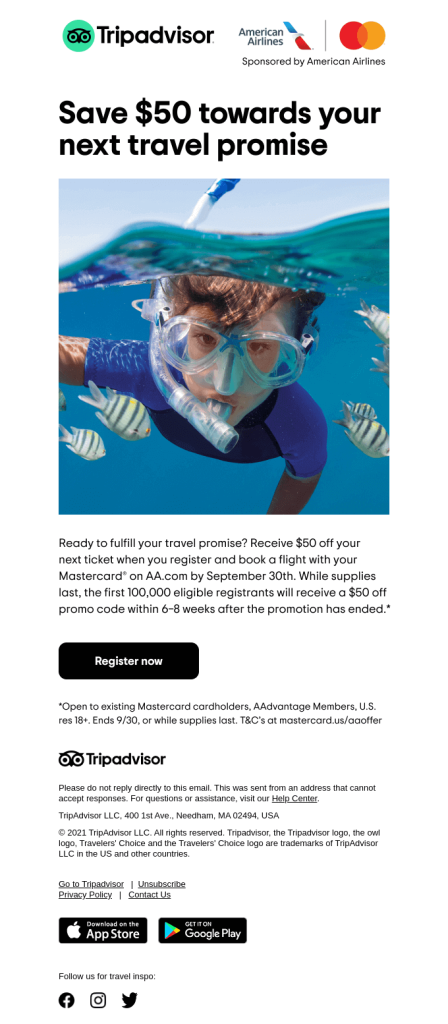
Display Ads: Since the first print newsletters were published, selling advertisements has been a tried-and-true technique of generating revenue.
Here is where you will introduce your newsletter to potential sponsors. They will receive dedicated ad space in your email newsletters to advertise their goods or services in exchange for an advertising fee.Finding businesses to pitch placements to can be time-consuming, which is the drawback of selling advertisements.
Example:

3. Affiliate Marketing
To begin with, register for an affiliate program with a company whose products you wish to recommend. After that, you can create unique affiliate links to use in your emails. You must promote products and services relevant to your audience.
It is crucial for publishers to declare any affiliate ties they may have with companies whose products they endorse, so that readers may make an informed decision about whether or not to believe the recommendations. Make sure your email service provider permits affiliate marketing if you intend to monetize your newsletter; otherwise, you run the risk of having your account closed. Note that adding affiliate links to newsletters is prohibited by several well-known affiliate networks, such Amazon Associates.
Example:
Here is an example of AppSumo promoting Oviond, a marketing data platform, through email affiliate marketing.

4. Product Sales
Digital Products: Selling digital goods to newsletter subscribers, like ebooks or virtual conferences, is another way for publishers to make money off of their free publications. This may include webinars presented by professionals on particular subjects you cover in your newsletter, which would increase its value.
Digital items are a good way to make money since, once made, they can be sold repeatedly with less additional labor. The drawback with digital products is that you don’t get recurring revenue like you would with memberships or paid subscriptions.
Example
This newsletter from the School of Basketry Art promotes a forthcoming paid basketry workshop.
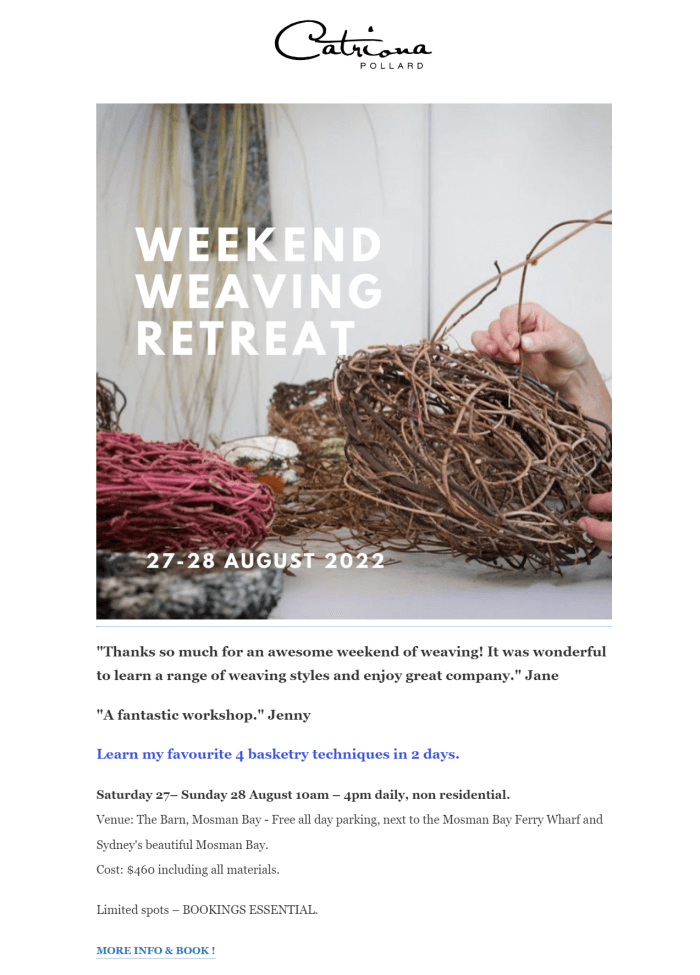
Physical Products: Do you have a branded merchandise line? Promote it in your newsletter as well! You might notice that whenever you mention something in your newsletter, fans on a sizable email list will take it up fast.
Your business gets exposed to a wider audience by having subscribers wear your merchandise, people who would not have otherwise heard of it. You can put a link to your merchandise store in the newsletter’s header or footer template.
Example
One such newsletter is Morning Brew/Marketing Brew, which awards branded items to subscribers who share the newsletter and earn points.
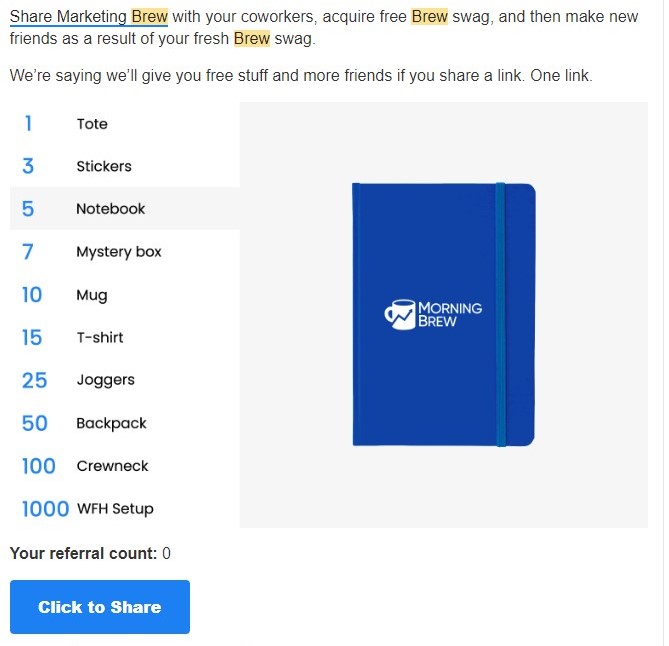
5. Donations and Crowdfunding
Donations: It’s perfectly fine to ask your followers to make donations. They value your work if they are glad to do it.
You can provide many ways to encourage people to make donations. You can use these three options: Buy Me a Coffee,PayPal,and Patreon.
Example
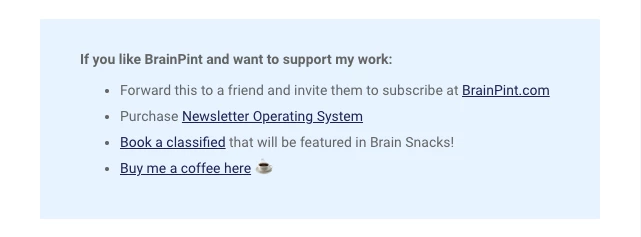
Crowdfunding: Nonprofit newsletters benefit most from this. Start crowdfunding campaigns to sponsor particular initiatives or projects. Each newsletter serves as a chance to highlight someone who benefits from your work and to request donations to support your ongoing efforts.
Similar to this, your crowdfunding campaign page needs to be completely branded with your company’s colors, logo, and fonts. Donors will feel more at ease contributing knowing that their money is truly supporting what you’re doing . Additionally, it helps increase brand recognition for your company, giving potential donors a positive first impression.
Example
Here’s a fantastic eample from Habitat for Humanity
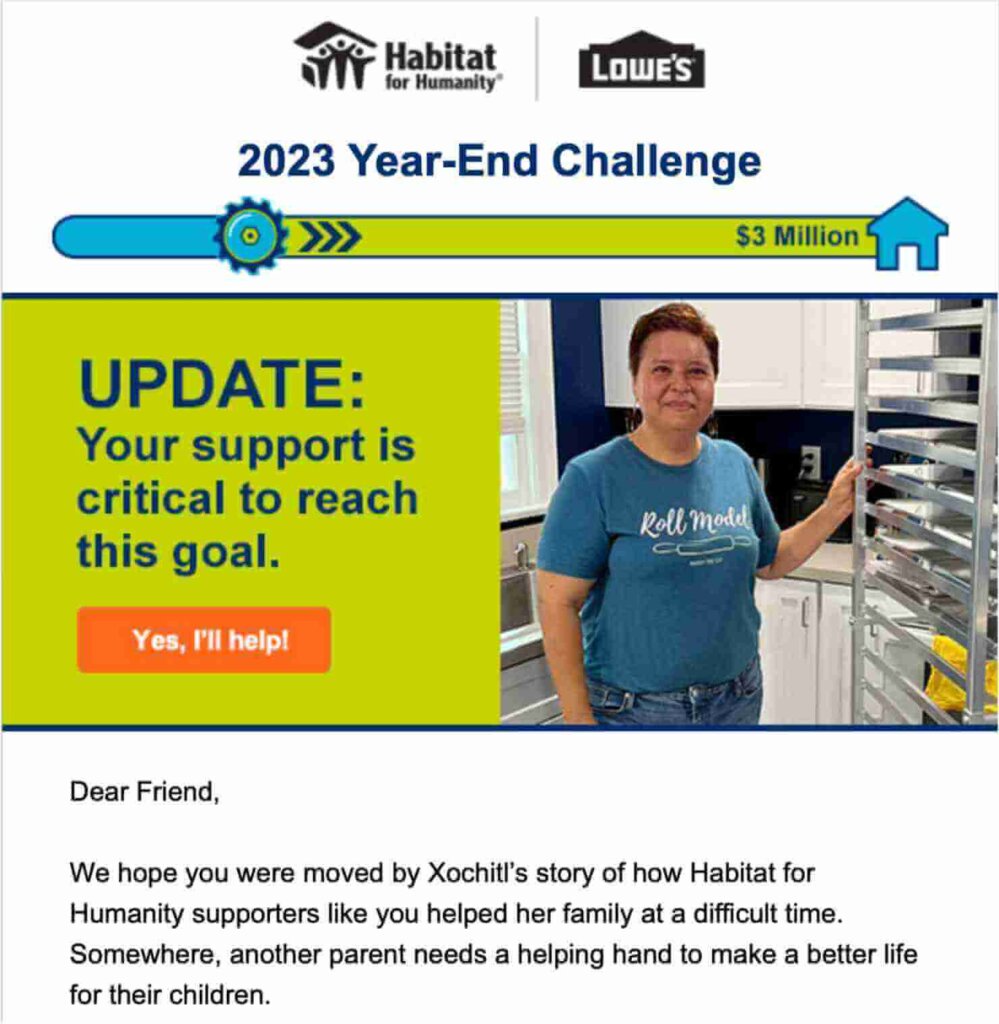
6. Exclusive Access and Eventscredit
You can charge a price to subscribers so they can access premium content from past newsletters.
You can also organize live online events or paid webinars that go deeply into your area of knowledge or expertise.
Example
The AMA and a local performing arts center collaborate on a special event in the example below. It advertises the $20 tickets in its newsletter.

7. Content Syndication
- License your content to other publishers or platforms for a fee.
8. Partnerships and Collaborations
Through partner networks, you can refer subscribers to other newsletters and receive payment each time a member of your list subscribes to one. Because many newsletter operators are eager to pay for new subscribers if you can provide them, this easy way of monetizing email lists works.
Example:
One excellent example of a partner network that lets you get money by encouraging your readers to subscribe to other newsletters is Sparkloop.

9. Job Boards and Classifieds
Classified ads are less expensive advertisements with one or two lines of text that sell or advertise something. One common type of classified advertising is job postings.
Promoting sponsored content in your newsletter should always be disclosed in the header and, most likely, the footer as well. To keep your audience interested, make sure your adverts are relevant to the tone and content of your email.
Example:
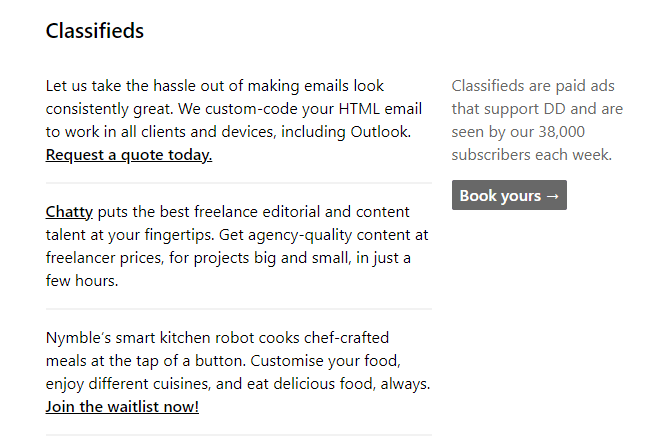
10. Consulting and Services
Making money off of your email list may also be achieved by offering services that are tailored to the requirements and preferences of your subscribers. Analyze your email statistics, track subscribers, and segment your email list based on the data you collect to find out what services your subscribers might be interested in. Providing services that suit the interests of your subscribers can boost sales and establish your authority in that niche.
You can also consult with your audience one-on-one to share your knowledge. Since the insights you obtain into your target audience can be applied to various forms of monetization, this is an excellent approach to start making money off of your email list.
But scaling up consulting is difficult. Make sure you have a well-organized procedure in place so you can focus on taking on consulting job you’ll enjoy and ultimately save time and energy.
Example:
Soledad Fernández Paulino of Wealth Para Todos provides a bundle of 12 sessions for $3,000.

Tips for Successful Monetization
- Know Your Audience: Understand your audience’s needs and preferences to offer relevant content and products. To find out about the requirements, preferences, and pain points of your audience, conduct surveys, examine engagement analytics, and communicate with them. Your monetization techniques will be more suitable and focused as you understand your audience. Your chances of converting customers are increased when you provide them with goods, services, or content that truly interests them.
- Provide Value: For your readers to devote time, focus, and money to your newsletter, it must be very appealing. Delivering excellent material that teaches, amuses, or solves problems should be your main priority.
- Build Trust: Establish trust with your audience by being transparent and delivering consistent quality. Whether introducing a paid subscription, giving an affiliate link, or endorsing a product, always be clear about your goals. Make sure that each recommendation or item that you endorse is something you sincerely believe in and that it corresponds with the interests of your audience.
- Experiment: Try different monetization strategies and see what works best for your newsletter. Observe the responses of your target audience to each tactic. Analyze performance with analytics, and be prepared to change course if necessary. You’ll eventually figure out the best methods to make money without sacrificing the credibility and worth of your newsletter.
By combining these strategies and continuously refining your approach based on feedback and analytics, you can effectively monetize your newsletter. It’s also important to remember that creating a newsletter for potential profit shouldn’t be your primary motivation; newsletters that are overly pushy will not succeed. You must also give your subscribers actual value. However, most of the time, success takes time. A lot of people invest years into growing their audience and subscriber base. Others, however, enter with ease and depart with enormous gains.